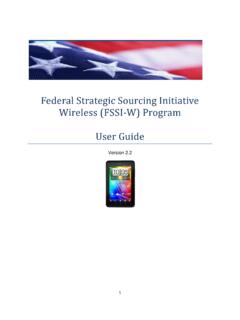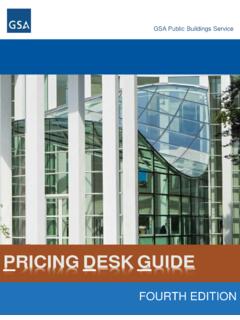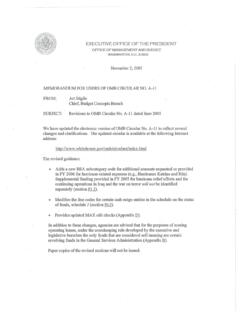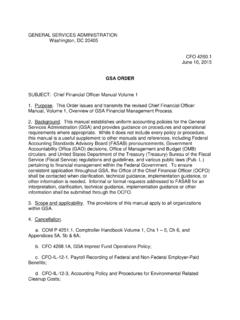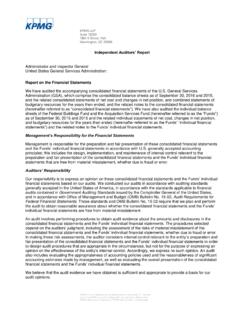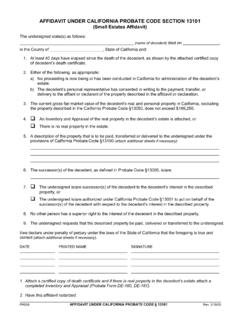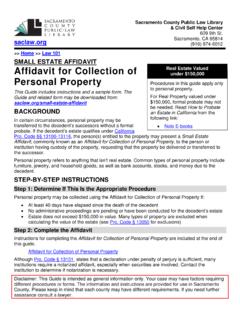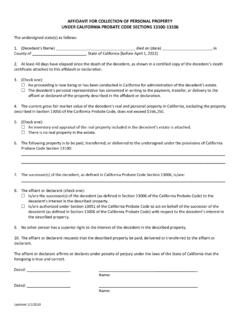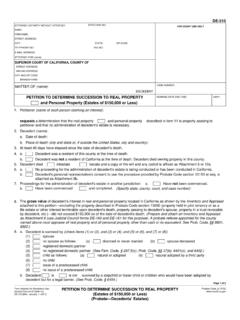Transcription of The Site Selection Guide
1 The site Selection Guide General Services Administration Public Buildings Service The site Selection Guide General Services Administration Public Buildings Service Office of the Chief Architect Table of Contents Foreword Introduction site Selection Philosophy 9 site Selection Process 19 Overview 21 Step 1: Confirm Readiness 24 Step 2: Develop the Work Plan 32 Step 3: Conduct Search 45 Step 4: Evaluate Long List 61 Step 5: Evaluate Short List/ 71 Recommend site (s) Troubleshooting Guide 83 NEPA Activities in site Selection 97 Appendices 109 A Glossary 111 B Major Federal Laws, Executive Orders, Regulations, and GSA Directives 118 C site Investigation Team Roles/ Responsibilities and Worksheet 121 D Sample Advertisement 132 E Professional Organizations and Resources for site Selection 134 Foreword Federal courthouses, office buildings, and other facilities represent the American government s presence in communities across the nation.
2 Not only do these buildings facilitate important federal missions, but they also can demonstrate clearly how the federal government contributes to improving the quality of life in local communities. These contributions include the creation of public spaces and plazas; the preservation of historic buildings and national landmarks; the commitment to improve environmen tal quality and energy conservation efforts; and, the potential to spark economic revitalization of our urban centers and business districts in both cities and towns. Critical decisions made at the very beginning of every capital development project have major consequences for the overall success of the project. The site Selection decision has a dramatic impact on almost every facet of the design and construction process. The site affects the organization; massing; functionality; sustainability; operational and economic efficiency; security; and last, but certainly not least, the aesthetic qualities of the building.
3 The site Selection is a life cycle" decision that recognizes the balance among the initial cost of the real estate, the overall cost of executing the project, and the cost of operating the facility. It also recognizes the benefit (or cost) to the local community and the envi ronment. While the initial cost may be a significant driver, all factors must be considered in order to make the right decision. In this Guide , the General Services Administration (GSA) posits a site Selection framework to assist the Project Team on the road to success. It addresses issues of both process and principle and is an extension of our quest to ensure that federal buildings are inviting, productive, efficient and safe places to conduct government business. We hope that this Guide can support GSA, our customer agencies, and our consultants in maintaining our legacy of quality public buildings. F. Joseph Moravec Commissioner of the Public Buildings Service General Services Administration Introduction The primary audience for this site Selection Guide is GSA s real estate and design professionals and the customer agencies.
4 A secondary audience for this Guide comprises the many stakeholders in the site acquisition process, including other members of the government, as well as GSA s partners. This Guide will be used by individuals possess ing a wide range of site acquisition, site Selection , and design knowledge. GSA has broad discretion in selecting sites for public buildings under 40 3304. This Guide provides an outline for the entire site Selection process. It is a menu of best site Selection practices, GSA experience, and recommendations. Suggestions include who the participants should be, what roles they play, when the various activities of the process occur, and where the requirements can be found. GSA recognizes that every site Selection is unique and that the required activities vary for every project. This Guide encourages best practices for site Selection in order to ensure completeness and consistency nationwide, to address the needs of the customer and the community, and to work toward a healthy environment.
5 It is based on the premise that site Selection is the first step toward responsible development. Most important, this site Selection The quality of site designGuide is a tool for finding the most appropriate sites from economic, programmatic, represents a significant and policy perspectives. federal investment and should, wherever possible, Benefits of Using the site Selection Guide make a positive contribu-By following the steps and suggestions in this Guide , the user can tion to the surrounding urban, suburban, or rural Ensure that the selected site is viable for the intended federal facility; landscape in terms of Reduce the risk of unanticipated difficulties and their impact in terms of schedule conservation, community and expense; design and improvement Manage expectations among participants and increase understanding of the site efforts, local economic Selection process; and development and plan Encourage innovation and creativity in the site Selection process while incorporat-ning, and environmental ing existing precedents and industrywide best practices.
6 Ly responsible practices." P-100, Facilities Standards for the Public Building Service The choice and develop ment of the building site should be considered the first step of the design process. This choice should be made in cooperation with local agencies. Special attention should be paid to the general ensemble of streets and public places of which federal buildings will form a part. Where possible, buildings should be located so as to permit a generous development of landscape." Sen. Daniel Patrick Moynihan (D NY) Tools and Resources This Guide includes useful tools and resources, such as simplified process charts, comprehensive checklists, project examples, sample worksheets, and examples, to illustrate the recommendations and suggestions. The following are some of the innovations in the Guide : Roles and responsibilities chart for GSA team members and contractors; Checklists of evaluation criteria; Strategies for interactions and communications with customer agencies and community stakeholders; Summary of major federal laws, Executive Orders, regulations, and GSA directives; List of resources for site Selection expertise, including GSA Web site sources and professional associations; Summary of the NEPA process as it relates to the site Selection process; and a Troubleshooting Guide that contains the answers to frequently asked questions about the site Selection process.
7 site Selection Philosophy These buildings will be here for hundreds of years long after we [have] relocated the last tenant, or written the last report. They should be in the right location that is our overriding responsibility." Jan Ziegler, Assistant Regional Administrator, Region 3 Las Cruces GSA s preferred site for a courthouse emerged when the city s plans changed. The project s ability to anchor Main Street and a study of parking impacts won the city s support. Philosophy site Selection has a long-lasting impact on every real estate decision that GSA makes. The process, issues, and criteria that support this decision are of great importance, not only to GSA, but also to the local and federal communities, the environment, and future generations. This Guide offers Regional Offices a framework for addressing important actions and performing evaluations in the Selection of sites for federal facilities.
8 GSA recognizes that every site Selection is unique and that each Project Team ultimately determines the best process for their project. The following discussion outlines the intent and philosophy of the federal government when selecting sites for new federal facilities. Location Location of federal facilities involves both the general area and the specific site . The location of a federal facility speaks volumes, a message heard years after construction is complete. It dictates almost everything that follows, from transportation access and environmental impact; to the federal government s involvement with local initiatives and economies; to the placement, form, and cost of the building. The selected site has a major impact on the customer agency in terms of convenience, access, and the quality of the work environment. It also has an impact on the project s ini tial and life cycle costs and on the community s economy, sense of place, and social fabric.
9 Federal law and Executive Orders ( ) address location choices. The Rural Development Act requires that agencies give first priority to rural areas, unless the agency mission or program requirements call for locations in an urban area. For projects located in urban areas, the primary Executive Orders that impact location are 12072 ( Federal Space Management," which requires first consideration to centralized community business areas) and 13006 ( Locating Federal Facilities on Historic Properties in Our Nation s Central Cities," which requires first consideration to historic properties within historic districts). Legacy GSA and the federal government have developed many programs and initiatives that support responsible development and stewardship of federal facilities. While each of these initiatives has its own identity, it is important to recognize the synergies among 11 programs, especially how programs support and inform each other.
10 site Selection lays the earliest groundwork for implementing these initiatives, so it is important to address the numerous initiatives in a coordinated fashion. Design Excellence and Construction Excellence The choice and development of the building site should be considered the first step of the design process. Finding the best site for the project enhances design and con struction excellence. The right site helps the Project Team and design professionals to address issues of quality, community, cost, security, and sustainability. Sustainability and Environmental Quality As the government s largest landlord, GSA is in a unique position to protect the environ ment while providing a quality workspace for its customer agencies. GSA strives to balance short-term project costs with long-term operations, environmental, social, and human benefits while meeting the intended needs of the facility. GSA is committed to incorporating principles of sustainable design and energy efficiency into all of its build ing projects, aiming for a Silver LEED rating for all of its projects.
